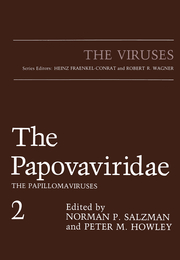Detailansicht
The Papovaviridae
The Papillomaviruses, The Viruses
ISBN/EAN: 9781475705867
Umbreit-Nr.: 4540436
Sprache:
Englisch
Umfang: 408 S., 113 s/w Illustr., 408 p. 113 illus.
Format in cm:
Einband:
kartoniertes Buch
Erschienen am 03.06.2012
Auflage: 1/1987
€ 53,49
(inklusive MwSt.)
Nachfragen
- Zusatztext
- In recent years there has been an explosion in research on the papillo maviruses. The viral nature of human warts was first suggested 80 years ago by Ciuffo, who demonstrated transmission using cell-free filtrates. Shope described the first papillomavirus over 50 years ago as the etiologic agent in infectious papillomatosis in rabbits. Subsequent studies by Rous established that benign rabbit papillomas induced by this virus could progress to carcinomas when treated with specific nonviral cofactors. Despite these rich beginnings, the papillomavirus field lay virtually dor mant until the late 1970s because no one was able to propagate these viruses in culture successfully. In the late 1970s the molecular cloning of the papillomavirus genomes permitted investigators to partially cir cumvent this obstacle to their progress. The cloning of the viral genomes permitted the standardization of viral reagents and provided sufficient material to begin a systematic evaluation of the biology of this group of viruses.
- Autorenportrait
- Inhaltsangabe1 Papillomaviruses: General Description, Taxonomy, and Classification.- I. Introduction.- II. Properties of the Virions.- A. Particle Structure and Protein Composition.- B. Nucleic Acid.- III. Biological Properties.- A. Characteristics of the Benign Tumors.- B. Immune Response of the Host.- C. Malignant Conversion-General Aspects.- IV. Classification and Nomenclature.- V. Description of Virus Types.- A. Human Papillomaviruses.- B. Bovine Papillomaviruses.- C. Other Papillomaviruses from Animals.- VI. Evolutionary Aspects.- A. Papillomaviruses and Miopapovaviruses.- B. Evolution of Papillomaviruses.- C. Papillomaviruses from Epidermodysplasia Verruciformis.- D. Reservoir of Papillomaviruses.- References.- 2 Animal Papillomas: Historical Perspectives.- I. Canine Oral Papillomatosis.- II. Shope Rabbit Papilloma.- III. Equine Papillomatosis.- IV. Bovine Papillomatosis.- V. Papillomatosis in Sheep.- VI. Oral Papillomatosis of Rabbits.- VII. Deer Fibromatosis.- VIII. European Elk Papillomaviruses.- IX. Viral Papillomatosis in Other Animals.- References.- 3 Organization and Expression of Papillomavirus Genomes.- I. Introduction.- II. General Properties of Papillomavirus Genomes.- III. The Genome of BPV-1.- A. Organization of the E (Transforming)-Region.- B. Organization of the L-Region.- C. The Noncoding Region.- D. Transcriptional Signals.- E. The Origin of DNA Replication.- IV. Comparative Anatomy of Papillomavirus Genomes.- A. Features of the HPV-la Genome.- B. Features of the HPV-6b Genome.- C. Features of the CRPV Genome.- D. Features of Other Papillomavirus Genomes.- V. Predicted Functions of Papillomavirus Proteins.- VI. Transcriptional Organization of Papillomavirus Genomes.- A. RNAs Expressed in Rodent Cells Transformed by BPV-1.- B. mRNAs Transcribed in Virus-Producing BPV-1-Induced Fibropapillomas.- C. The Transcription Map of the BPV-1 Genome Is Incomplete.- D. Transcriptional Organization of the CRPV Genome.- E. Common Features between BPV-1 and CRPV Transcription.- F. Transcriptional Organization of Human Papillomavirus Genomes.- VII. Conclusions.- References.- 4 The Expression of Papillomaviruses in Epithelial Cells.- I. Introduction.- II. Epithelium and Keratinization.- III. Behavioral Classification of PVs.- IV. Histological Characteristics of PV-Induced Lesions.- V. Transformation.- VI. Vegetative Viral Growth.- VII. Cytopathic Effects.- VIII. Expression of PV in Cultured Keratinocytes.- IX. Expression of PV in Malignant Cells.- X. Conclusions.- References.- 5 Papillomavirus Transformation.- I. Introduction.- II. Transformation Biology.- III. Transcription.- IV. Transforming Functions.- A. Genetics.- B. E6 Gene.- C. E5 Gene.- D. E2 Gene.- V. Plasmid Maintenance Functions.- A. Cis Elements.- B. Trans Functions.- VI. Summary and Conclusions.- References.- 6 Papillomaviruses and Carcinogenic Progression I: Cottontail Rabbit (Shope) Papillomavirus.- I. Introduction.- II. Biological Properties of the System.- A. Virus Multiplication and Tumor Induction.- B. Tumor Progression.- C. Interaction with Chemical Carcinogens.- D. Regression.- III. Molecular Aspects of the System.- A. The Virus and Viral Genome.- B. State of the Viral DNA.- C. Viral Transcripts.- D. Conclusion.- References.- 7 Papillomaviruses and Carcinogenic Progression II: The Mastomys natalensis Papillomavirus.- I. The Animal System.- II. Epithelial Skin Tumors in Mastomys.- III. Identification of MnPV as the Causative Agent of Skin Tumors.- IV. Characterization of the Virus.- V. Persistence of MnPV Genomes in Normal Tissues.- VI. Accumulation of Viral DNA in Normal Skin during Aging.- VII. MnPV Genome Expression in Tumors.- VIII. Induction of MnPV by Tumor Promoters.- IX. Induction of Antibodies against MnPV in Mastomys.- References.- 8 Epidermodysplasia Verruciformis.- I. Introduction.- II. Clinical Aspects of EV.- A. Clinical Course of the Disease.- B. Morphology of EV Lesions.- III. Histology and Ultrastructure of EV Lesions.- A. Benign Lesions.- B. Malig
